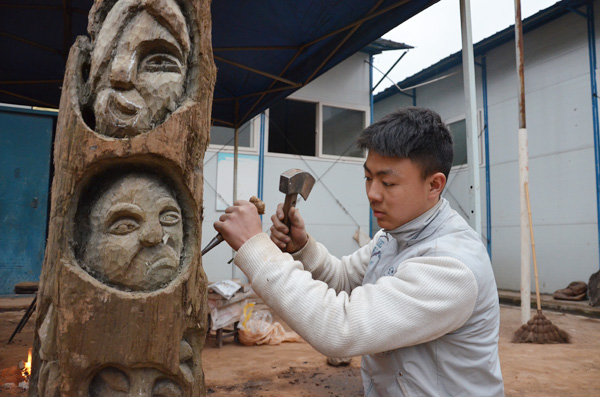A rootcarving apprentice practices on a trunk in Lushan, Sichuan province. The county is the biggest ebony root carving market in China. Peng Chao / China Daily

Thousands of craftsmen working in the ebony industry severely hit by disaster two years ago
Two years after being hit by a magnitude-7.0 earthquake, Lushan county in Sichuan province is striving to recover its root carving industry in an effort to preserve the traditional art form and boost the local economy.
Lushan is the biggest ebony root carving market in China. Some 220 workshops, 1,200 craftsmen and 8,000 others are engaged in the industry. The annual output was worth 1 billion yuan ($161 million) before the quake.
Tang Guofu, 61, one of the earliest and best-known root carving masters in the county, is devoted to teaching root carving to students from around the county and the province.
With support from the local government, he has taught more than 100 students since 2013 without charging.
Lushan abounds in ebony and some of the roots are semi-fossilized and have been underground for thousands of years. The wood is mainly found in Sichuan province, and is perfect for root carving.
Products cost from several thousand to hundreds of thousands yuan and are sold all over the country and also overseas in countries including the United States, Canada and Singapore.
The ebony root carving industry was severely affected by the Lushan earthquake. Thousands of carving pieces and most of the workshops were damaged and the output value dropped to 400 million yuan in 2013.
Tang said he has enjoyed carving since childhood. He taught himself the art form while working in the county museum. In the 1990s, he started to make sculptures with ebony, and many villagers learned from him. Dozens of shopkeepers in the root carving street are his students.
"The art of wood carving in Lushan dates to the Western Han Dynasty (206 BC-AD 24)," Tang said. "Different from the delicately carved and polished works by artists and craftsmen in Fujian and Zhejiang, the ebony root carving works in Lushan are presented through the natural shapes of the root material."
Tang said he teaches carving to those who don't have other skills to make a living, and to preserve the art and industry.
"One important thing is that while teaching young people, their fashionable and creative ideas also give me inspiration," he said.
Tang is expecting more exchanges with foreign artists. The county used to hold an exchange, inviting 10 carvers from countries including Belgium, Brazil, Egypt and the United Kingdom.
Wang Wencheng, 33, who has studied root carving since he was 16, runs a workshop in the root carving street. He said business dropped sharply after the quake, but he is confident that the industry will recover.
"We have the best material here. A new highway is under construction and an Ebony Root Carving Art City is being planned. As long as the market grows bigger and more craftsmen and businessmen come, the industry is sure to flourish again," he said.
Chen Yan, director of the management committee of the Ebony Root Carving Art City, said the district will cover 1.5 square kilometers, with investment of 800 million yuan. It will consist of a raw materials market, a product trade market, a processing park and a creative industry center.
The art city will attract top craft masters from the national and provincial level, and top companies in the industry, Chen said.
According to the plan, the output value of the county's ebony root carving industry will reach 2 billion yuan by 2020, creating 15,000 jobs.
Contact the writer at liyu@chinadaily.com.cn and pengchao@chinadaily.com.cn
